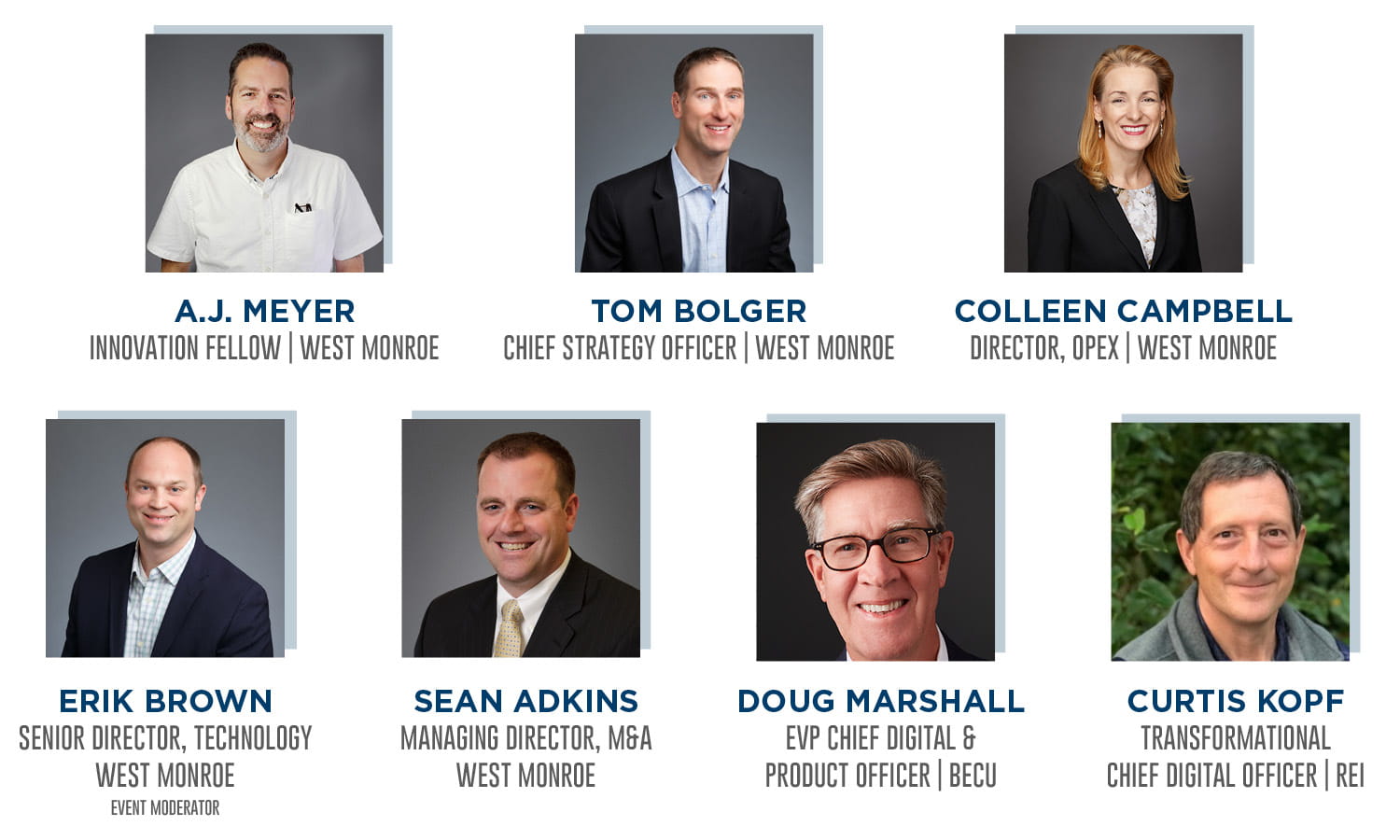Q&A roundtable: Innovation in an uncertain market
Where do organizations begin, who’s doing it well, and what does success look like? Here’s what our panelists said.
COVID-19 has changed the way businesses work and, thus, innovate. West Monroe recently hosted a webinar to discuss how organizations are handling the burden and opportunity of innovation while also meeting the immediate needs of their employees, customers, and clients.
Topics included which industries are thriving, which would be doing more, balancing innovation, what kind of innovation will define the COVID era, and what innovative success looks like during a time in which financial goals have been more difficult to come by.
Below are some of the highlights from the hourlong webinar. You can watch the webinar in its entirety here.
How do companies balance innovation investment while dealing with immediate needs, and where are the biggest shifts being made?
Kopf: One of the enemies of innovation is success. That model has worked really well and that can be an argument against risk taking. Where we sit right now, we need to allocate more money to innovation. The customer is changing, the business model of a retailer for the last decade-plus, it doesn’t work in a post-COVID environment. We now need to innovate both around the customer and around our business model. It takes discipline, and it means making hard choices. It could mean starving the core business to invest in something that’s uncertain. This requires new skills. When you’re making incremental change to the known playbook, that is very different than jumping into the unknown. That’s what we’re experiencing now as we shift some of our resources to innovation.
Meyer: As I think about uncertain times in innovation, there tends to be a talent shuffle. Out of that, comes new start-ups. And even when you have talent coming out of the various best schools in the country where there aren’t jobs readily available, they’re starting to form their own start-ups. And so the thing that existing companies need to worry about is this concept called “death by 1,000 start-ups.” And so you have to work at innovating to stave off that attack.
Marshall: On the talent front, one of the things we’re seeing is if innovation requires different kinds of talent – and it does for us in a category like financial services – and uncertainty makes people pause and think, “purpose maybe matters both more as consumers and employers,” we’re seeing more opportunity to attract talent.
Are there any industries that are missing an opportunity to innovate?
Adkins: One that bubbles to the top of my mind is commercial real estate. In my mind, there’s a real opportunity for firms to be changing the market. Go buy real estate, become your own WeWork, offer flexible space, give customers the opportunity to engage with you in different ways vs. a traditional lease, or even think about office pods and deploy them in neighborhoods so that people who have to sit at home and work with kids and others around have a place to retreat to and go work.
Bolger: I would offer up the consulting industry. I graduated college over 25 years ago and the way that we do work is virtually the same today as it was 25 years ago. I’m interested to see how that transforms over time, how does the digitization of some of these industries that are high-touch, relationship-based, we’ve been very redescent to figure out how to use technology in those emotional, long-running transactions, consulting being one of them.
Campbell: I work a lot with the Utilities industry, and the culture and the speed of innovation varies greatly within different industries. I think the opportunity is for those industries that can jump in and innovate, and the more that they can create a niche or an area that innovates or does something differently, it’s going to push them over. It’s a way to differentiate yourself in that space as a leader.

Will there be a defining innovation that comes out of this crisis?
Campbell: The biggest thing we’re seeing impact our clients is virtual. How do you move to virtual? How do you make things work where you don’t have to come to a physical location? It’s been tremendous to see how many of our clients around the world are responding to that and making it work. That is going to continue to change our business models and how we work.
Marshall: I wonder about analog becoming even more robustly analog, whether it’s the store down the street that still cares about you as a human. That person-to-person connection still matters.
Bolger: I do think we know what the big challenge is, is that in-person interaction. It’s a high probability that innovation is going to deal with that. I do think behavioral health is another area where we’re going to see a lot of innovation, but having to do with people’s well-being. I do think people slowed down long enough to realize that old models weren’t the healthiest, most sustainable. For all this talk of technology, I think the humans is where we’re going to innovate.
What is the relationship between innovation and employment/working conditions?
Campbell: From a process standpoint, it could go either way depending on what you’re doing. It also frees up people move from more manual-level roles to doing more thinking or more advanced skill sets, and that can be an empowering thing from an employee job satisfaction level. So if we look at it from that perspective, it can make a huge difference in people’s lives overall.
Meyer: What if we look at how we interact with each other, and maybe the pandemic has shown a little bit of light on this, where we’ve become so specialized in what we do: We wake up, we go to the office, and we specialize in what we do, we come home, we see the kids, go to bed, and restart that whole thing. I’ve heard stories from people saying “I’ve been home for dinner every night for the last 8 months and it’s been awesome. I love this!”
What if we were to allow innovation and process automation to take over some of these human tasks, and what if we were to spend our time focusing on teaching our kids, what if we were to use some of our time to work on health and wellness? We have an opportunity to take what we do caring for each other and our families and advance that.
How do you measure innovation success?
Kopf: Product-market fit. Does the customer like it and use it? Just start there. Second, is the market big enough to even care about? For traditional organizations, putting a measurement on it is harder. If you’re measuring learning, that’s interesting. But for big companies, that’s a new way of thinking.
Meyer: How might we create scorecards around impact and purpose? If we are innovating and we’re doing so in a socially positive way, if we are helping our communities to do better, can we come up with an impact score? Those are things that will help us retain and attract the very best talent, which then feeds innovation and the power of our organizations.
Campbell: There’s definitely a financial component in most cases, but there’s the question of how is this impacting the customer experience? How is it affecting employees? And how is it operationally making things work better? There’s a lot of different levers to pull. It’s important to not just look at the financial one.
Adkins: We have more data than we’ve ever had available to measure these outcomes. You can track someone’s engagement through a lot of channels, and the trick then is how do you take that massive data set and correlate it so that you actually can get meaningful insights about what your members want and where they need you.
Marshall: We’ve developed a financial health score for each of our customers. We measure success by have we improved Cohort X’s financial well-being. We’re trying to figure out how that affects the communities they live in, too.
Bolger: This notion of risk tolerance is absolutely critical. How do you convince senior leadership to take risks in this uncertain environment? Clearly, you have to have some non-financial factors…Innovation is difficult, and it’s hard to do. And it’s more about moving past this financial ROI to some other metric, whether it’s mission-driven or measuring learning. I am convinced that that’s part of the key.


